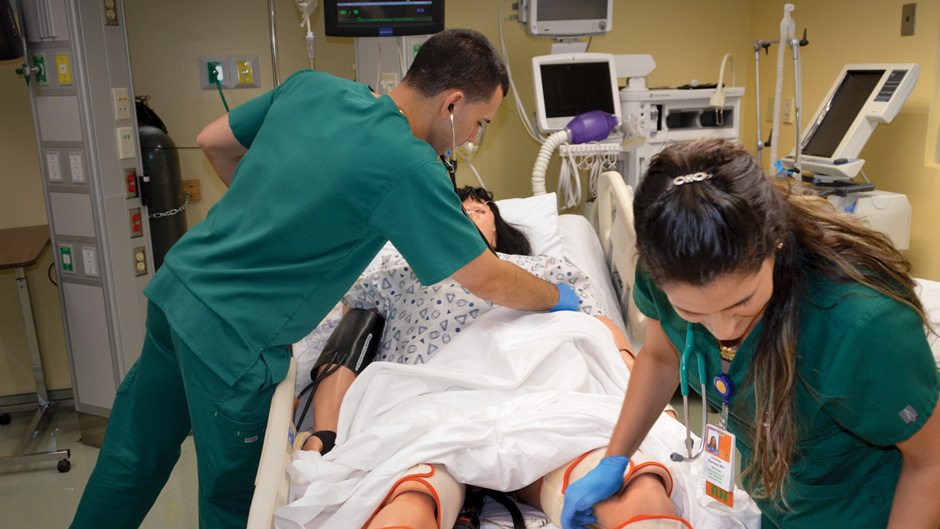Simulation is a powerful tool for the preparation of today’s health care professionals, and the School of Nursing and Health Studies (SONHS) is a national leader in the use of sophisticated simulation technologies and techniques to improve nursing education.
The school’s robust cohort of high-tech patient simulators, complete with breathing, blinking, and vital signs, can replicate an array of chronic and acute health conditions that students must address in real time. The “sims,” in turn, respond to the students’ interventions—for better or worse. In this living laboratory, difficulties or errors become teachable moments in post-scenario video debriefing sessions. The resulting experiential learning cycle—react, evaluate, apply newly gained insights—improves both basic and advanced nursing skills.
Imbedded within the SONHS curriculum, the school’s superb simulation resources are now being deployed to optimize the skills of nurses entering the workforce through an educational and training partnership with University of Miami Hospital (UMH). The trainings are a first for both SONHS and UMH, where nurse educators previously used only in-house assets to orient their new-to-practice nurses.
The program was sparked by a suggestion from UMH nurse educator Jessica Joseph. “As a graduate of SONHS, I know the quality of the school’s simulation education equipment, facilities, and personnel,” Joseph said. “So I suggested that we explore opportunities for our new nurses to benefit from these outstanding training resources.”
Joseph’s UMH colleagues, aware of both the benefits of simulation training and SONHS’s extraordinary simulation capabilities, were receptive to the idea. They reached out to SONHS, and the two institutions developed the program together.
The program launched last May as a series of three training modules attended by 22 UMH nurse residents, recent graduates of SONHS and other R.N. granting institutions. The sessions were led by Susana Barroso-Fernandez, assistant professor of clinical and director of simulation operations at SONHS. Three SONHS nurse specialists performed roles during simulations and provided feedback during debriefing sessions; SONHS simulation specialists oversaw the technical components. Joseph and her UMH nurse educator colleagues Afreen N. Kisten and Shana Russey, along with Joseph Falise, UMH’s director of Organizational Learning, worked closely with the school throughout the development and implementation of the program.
As the sessions got underway, the newly hired UMH nurses talked about the stresses they were already experiencing on the job. Many spoke of beginning a shift having “done their homework” and feeling fully prepared, only to discover that a patient’s condition had completely changed—and that they needed to adapt their care plan on the spot.
Learning how to meet such challenges, said Barroso, is exactly the point of the UMH-SONHS simulation training. “It’s OK to feel a lot of frustration as a new nurse,” she said. “Nursing school taught you conceptual knowledge and clinical skills; your first year on the job teaches you how to be a nurse.”
The lessons to be reinforced are often as much about communication as they are about strictly clinical skills. One simulation scenario, for example, focused on a Chronic Obstructive Pulmonary Disease inpatient awaiting hospital discharge orders and his overwrought wife, whose anxiety was disrupting the process.
“The debriefing video showed the distance that the nurses tended to place between themselves and the agitated family member,” Joseph said. “They could see the difference between acknowledging the family member’s concerns solely with words as opposed to also conveying empathy by closing the physical space between them.”
“As a new nurse, I’ve discovered that stressful moments with family members happen all the time,” said UMH nurse resident Antonia George. “After this training, I feel like I can now walk into a patient’s room and assess the situation with much more confidence.”
“The connection between this experience and the patient care we provide is real and immediate,” said Julia Frank. “We know that we’re going to incorporate what we’ve learned into our practice right away.”
UMH nursing trainee Carey Kaplanek agreed. “I’ve already noticed myself incorporating these concepts while interacting with my patients,” she said.
UMH nurse educator Falise notes that the impact of the training is intensified by the close relationship between the two institutions. “SONHS simulation labs have the same IV pumps, beds, and ventilators as those at UMH,” he said. “So SONHS is an ideal setting for teaching our nurse residents UMH-specific protocols, policies, and practices that they can seamlessly transfer over to the patient care setting.”
“The time and effort both institutions have devoted to implementing this marriage of academia and hospital-based practice will allow our nurses to better perform their roles not only in our hospital, but wherever they go afterwards,” Joseph said. “Ultimately, the training has the potential to improve outcomes among all the patient populations whom these nurses care for throughout their nursing careers.”
The program is also yielding valuable information for the SONHS simulation team. “The process of helping new nurses to become more highly skilled in their work is a learning opportunity for us as well,” Barroso said. “By observing how they react in the clinical simulation sessions, our faculty sees what may be lacking in the undergraduate nursing curriculum. We can then propose curriculum modifications to address those gaps.”
The new SONHS’s Simulation Hospital holds the potential to dramatically expand this novel training program and others like it. The extraordinary new facility uses the latest simulation technology to provide SONHS students, public health professionals, and practicing nurses with the highest-quality healthcare education in a wide variety of simulated clinical environments.
“It is our responsibility as educators preparing the nursing workforce of tomorrow to see what’s going on in the real world of healthcare after our graduates enter the field,” Barroso-Fernandez said. “We can then integrate that understanding into our nursing education ‘best practices,’ and better prepare nurses to care for patients in a safe manner. It always comes back to patient safety.”

